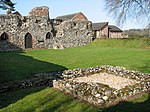Herringfleet Windmill
Grade II* listed buildings in SuffolkGrade II* listed windmillsIndustrial buildings completed in 1820Mill museums in EnglandMuseums in Suffolk ... and 6 more
Octagonal buildings in the United KingdomSmock mills in EnglandTowers completed in 1820Use British English from July 2016Waveney DistrictWindmills in Suffolk

Herringfleet Mill or Walker's Mill is a Grade II* listed smock mill at Herringfleet, Suffolk, England, Now in a bad state of repair with two of the 4 sails removed.
Excerpt from the Wikipedia article Herringfleet Windmill (License: CC BY-SA 3.0, Authors, Images).Herringfleet Windmill
Sandy Lane,
Geographical coordinates (GPS) Address External links Nearby Places Show on map
Geographical coordinates (GPS)
| Latitude | Longitude |
|---|---|
| N 52.5207 ° | E 1.6327 ° |
Address
Herringfleet Windmill
Sandy Lane
NR31 9HW , Fritton and St. Olaves
England, United Kingdom
Open on Google Maps










